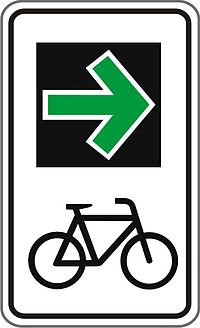Tag:restriction:bicycle=stop
 |
| Description |
|---|
| Used where cyclists may turn right at red signal after stopping |
| Group: restrictions |
| Used on these elements |
| Requires |
| See also |
| Status: in use |
| Tools for this tag |
|
restriction:bicycle=stop is used to indicate a stop for bicycles after turning on red was allowed by a sign. This is used at traffic lights where bicycles are allowed to pass at a red light after coming to a stop.
This restriction aligns with the concept of a "Grünpfeil" (green arrow) commonly used in German-speaking countries, allowing cyclists to safely navigate intersections while respecting the right-of-way of other road users. When a cyclist encounters a red traffic signal and intends to turn right, they must first come to a complete stop, yield to any oncoming traffic or pedestrians, and then proceed with their right turn when it is safe to do so. This is for example used in Austria.
How to map
Create a relation with following members
 way cyclists arrive with the role
way cyclists arrive with the role  from
from node with the traffic sign (traffic_signals) with the role
node with the traffic sign (traffic_signals) with the role  via
via- optional:
 way(s) following the "from"-way leading to the "to"-way with role
way(s) following the "from"-way leading to the "to"-way with role  via
via  way cyclists go to after having stopped with the role
way cyclists go to after having stopped with the role  to
to
Members
| Way or node | Role | Recurrence | Discussion |
|---|---|---|---|
|
1 1 or more |
A way from which restriction starts (e.g., right turn for cyclists from here). | |
|
1 1 or more |
The other end of the restriction (where to turn in). | |
|
1 node 1 or more way(s) |
The A turn restriction can either have one The |
See also
- Red turn
- Map showing red turns for bicycles: https://www.openstreetbrowser.org/#map=14/48.2034/16.3855&basemap=osm-mapnik&categories=plepe/test/cycle_turn_on_red